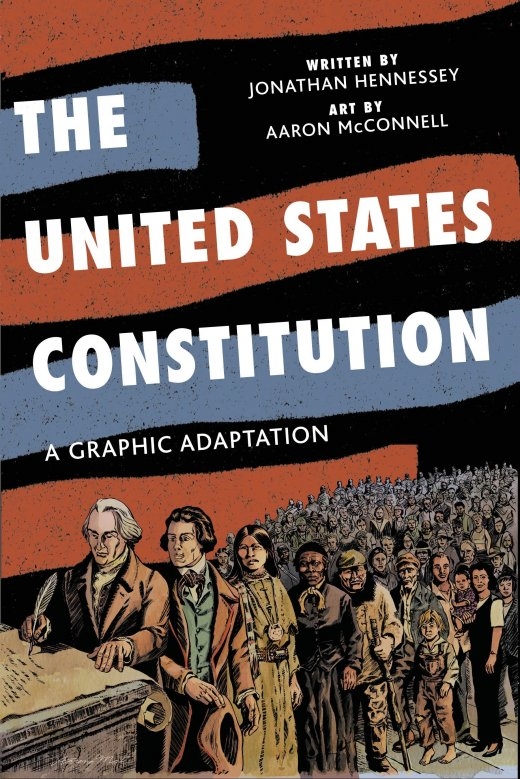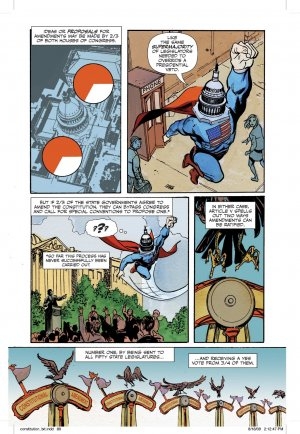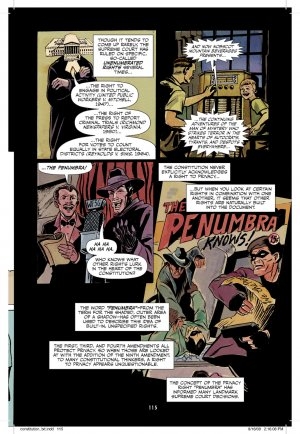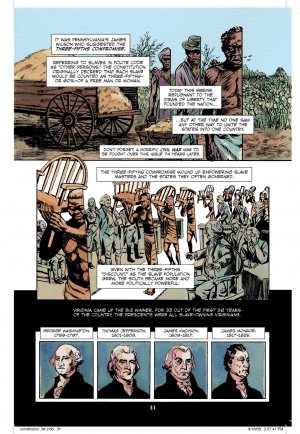
BY JONATHAN VALANIA Every school boy and girl is taught that the Constitution is the most sacred document in the history of human freedom, that its wisdom is unimpeachable and that its reach and authority shall not be denied by the tyranny of evil men. And then there is the actual history of the U.S. Constitution, which is not quite as tidy and high-minded as they teach you in school. Still, it remains a beacon of democratic hope in a dark and largely un-democratic world. With all this in mind, writer Jonathan Hennessey and illustrator Aaron McConnell bring us this must-read graphic novel treatment of the history, meaning and evolution of the United States Constitution. It should be a staple of every high school history class.
PHAWKER: Your bio says you worked for Hollywood prior to writing this book. Did you work on any movies we  might have heard of?
might have heard of?
JONATHAN HENNESSEY: I was a production assistant on a movie called Rushmore.
PHAWKER: That works for me.
JONATHAN HENNESSEY: I have been a writer my whole life, but this Constitution graphic novel thing is the first time I have gotten the attention of publishers.
PHAWKER: What was the impetus for the project?
JONATHAN HENNESSEY: I grew up in Massachusetts and, like Philadelphia, it is ground zero for lot of American history. I have always been deeply interested in history, law and politics. And with an election coming up, I thought it would be great if everybody that votes actually read the Constitution beginning to end.
PHAWKER: This is an amazing teaching tool, I think, have you considered trying to get this into the schools as a history textbook?
JONATHAN HENNESSEY: We are going to try. But as you can imagine, if evolution is controversial, there will be a lot of pushback on the history of the Constitution, because a lot of it ain’t pretty.
 PHAWKER: How long did the project take beginning to end?
PHAWKER: How long did the project take beginning to end?
JONATHAN HENNESSEY: Two years beginning to end. I spent nine months researching the manuscript and then turned it over to the illustrator, Aaron McConnell, and it took him about one day to do each page. The whole book is almost 150 pages.
PHAWKER: So what did you learn about the Constitution along the way?
JONATHAN HENNESSEY: How codified slavery really is in the original version. It’s why we have an electoral college, it’s why we have two houses of Congress, not to mention why we used to have the Fugitive Slave Provision. If you look closely, you can see slavery in every corner of the Constitution, even in places you would never expect. The Constitution was both a tool of freedom and a tool of oppression. It was used to disqualify all sorts of Americans from political life.
PHAWKER: Explain that.
JONATHAN HENNESSEY: Well, representation in Congress was based on the size of state populations. Back then there were far more people living in the North than the South. So the South came up with a way of counting the slave populations of their states to increase their numbers. It was called the 3/5 Compromise, which basically said that each slave counted as three fifths of a free white man, or 60%. That lasted until the 13th Amendment was passed after the Civil War.
PHAWKER: It is my understanding that during Reconstruction, southern blacks voted in enormous numbers —  almost 100%, until the KKK and the Jim Crow Laws came along and pretty much turned the clock back to the slave days with intimidation and violence.
almost 100%, until the KKK and the Jim Crow Laws came along and pretty much turned the clock back to the slave days with intimidation and violence.
JONATHAN HENNESSEY: Oh, those were very, very bloody times — blacks shot in the street as they waited in line to vote. And then they introduced the Poll Tax, which basically meant you had to pay to vote, and most poor sharecroppers could not afford to pay. That went on until very recently. The Poll Tax wasn’t repealed until the Civil Rights legislation of the early 1960s.
PHAWKER: Women were completely disenfranchised, too.
JONATHAN HENNESSEY: In the original Constitution, the right to vote was granted by the states. Back then women were considered property of their husbands or their fathers. They had no right to own property, unless it was bequeathed to them in a will. In many states you could only vote if you were a property owner. Women could not sue in a court of law. That didn’t really change until the 19th Amendment came along in 1920, which said that voting was a Federal right, and states could not discriminate on voting rights.
PHAWKER: That is really shocking that women have only been allowed to vote in this country since 1920.
JONATHAN HENNESSEY: And famous suffrage advocates like Susan B. Anthony and Elizabeth Stanton worked their whole lives to earn women the right to vote. Neither lived to see the day that women were allowed to vote.
 PHAWKER: With what we know about NSA monitoring the phone calls, emails and web use of every American, does the Fourth Amendment — which protects Americans from unreasonable search and seizure — even exist anymore?
PHAWKER: With what we know about NSA monitoring the phone calls, emails and web use of every American, does the Fourth Amendment — which protects Americans from unreasonable search and seizure — even exist anymore?
JONATHAN HENNESSEY: The Fourth Amendment is in trouble. But this surveillance of Americans you are talking about has yet to pass the judicial litmus test. None of the lawsuits that have been filed have gotten to the Supreme Court, though. In order to sue the Federal government for spying on you, you have to be able to prove that you are being spied on, and the government refuses acknowledge who is and who isn’t being spied on. So the lawsuits keep getting thrown out.
PHAWKER: I find all this to be deeply, deeply troubling. It just seems so patently un-American.
JONATHAN HENNESSEY: I agree, but at the same time I am hopeful we will right ourselves, as we have so many times before. The Constitution has been in trouble before, but it continues to bring more people liberty than any other document.
***
The National Constitution Center will welcome veteran film and television writer, Jonathan Hennessey, to present a groundbreaking way to read and understand the United States Constitution. In The United States Constitution: A Graphic Adaptation, Hennessey uses the popular medium of graphic art to illustrate and breathe new life into our nation’s cornerstone principles. This program will take place on Wednesday, October 22, 2008, at 6:30 p.m. Admission is free, but reservations are required and can be made by calling 215.409.6700. During the program, Hennessey will present portions of the book with an animated, multimedia slideshow produced from Aaron McConnell’s artwork. These highlights will focus on “myth-busting” common assumptions about American law and politics, and making a provocative case for both its flaws and its enduring ingeniousness. Hennessey will also give a behind-the-scenes look at how a graphic novel is made.
